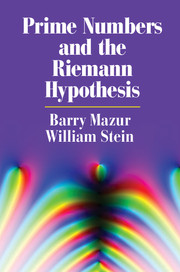Book contents
- Frontmatter
- Contents
- Preface
- PART I The Riemann Hypothesis
- 1 Thoughts About Numbers
- 2 What are Prime Numbers?
- 3 “Named” Prime Numbers
- 4 Sleves
- 5 Questions About Primes
- 6 Further Questions About Primes
- 7 How Many Primes are There?
- 8 Prime Numbers Viewed from a Distance
- 9 Pure and Applied Mathematics
- 10 A Probabilistic First Guess
- 11 What is a “Good Approximation”?
- 12 Square Root Error and Random Walks
- 13 What is Riemann's Hypothesis?
- 14 The Mystery Moves to the Error Term
- 15 Cesàro Smoothing
- 16 A View of|Li(X)-π(X)|
- 17 The Prime Number Theorem
- 18 The Staircase of Primes
- 19 Tinkering with the Staircase of Primes
- 20 Computer Music Files and Prime Numbers
- 21 The Word “Spectrum”
- 22 Spectra and Trigonometric Sums
- 23 The Spectrum and the Staircase of Primes
- 24 To Our Readers of Part I
- PART II Distributions
- PART III The Riemann Spectrum of the Prime Numbers
- PART IV Back to Riemann
- Endnotes
- Index
19 - Tinkering with the Staircase of Primes
from PART I - The Riemann Hypothesis
Published online by Cambridge University Press: 05 May 2016
- Frontmatter
- Contents
- Preface
- PART I The Riemann Hypothesis
- 1 Thoughts About Numbers
- 2 What are Prime Numbers?
- 3 “Named” Prime Numbers
- 4 Sleves
- 5 Questions About Primes
- 6 Further Questions About Primes
- 7 How Many Primes are There?
- 8 Prime Numbers Viewed from a Distance
- 9 Pure and Applied Mathematics
- 10 A Probabilistic First Guess
- 11 What is a “Good Approximation”?
- 12 Square Root Error and Random Walks
- 13 What is Riemann's Hypothesis?
- 14 The Mystery Moves to the Error Term
- 15 Cesàro Smoothing
- 16 A View of|Li(X)-π(X)|
- 17 The Prime Number Theorem
- 18 The Staircase of Primes
- 19 Tinkering with the Staircase of Primes
- 20 Computer Music Files and Prime Numbers
- 21 The Word “Spectrum”
- 22 Spectra and Trigonometric Sums
- 23 The Spectrum and the Staircase of Primes
- 24 To Our Readers of Part I
- PART II Distributions
- PART III The Riemann Spectrum of the Prime Numbers
- PART IV Back to Riemann
- Endnotes
- Index
Summary
For starters, notice that all the (vertical) risers of this staircase (Figure 18.1 above) have unit height. That is, they contain no numerical information except for their placement on the x-axis. So, we could distort our staircase by changing (in any way we please) the height of each riser; and as long as we haven't brought new risers into – or old risers out of – existence, and have not modified their position over the x-axis, we have retained all the information of our original staircase.
A more drastic-sounding thing we could do is to judiciously add new steps to our staircase. At present, we have a step at each prime number p, and no step anywhere else. Suppose we built a staircase with a new step not only at x= p for p each prime number but also at x = 1 and x = pn where pn runs through all powers of prime numbers as well. Such a staircase would have, indeed, many more steps than our original staircase had, but, nevertheless, would retain much of the quality of the old staircase: namely it contains within it the full story of the placement of primes and their powers.
A final thing we can do is to perform a distortion of the x-axis (elongating or shortening it, as we wish) in any specific way, as long as we can perform the inverse process, and “undistort” it if we wish. Clearly such an operation may have mangled the staircase, but hasn't destroyed information irretrievably.
We shall perform all three of these kinds of operations eventually, and will see some great surprises as a result. But for now, we will perform distortions only of the first two types.We are about to build a new staircase that retains the precious information we need, but is constructed according to the following architectural plan.
• We first build a staircase that has a new step precisely at x = 1, and x = pn for every prime power pn with n≥ 1. That is, there will be a new step at x= 1, 2, 3, 4, 5, 7, 8, 9, 11, . . .
- Type
- Chapter
- Information
- Prime Numbers and the Riemann Hypothesis , pp. 53 - 55Publisher: Cambridge University PressPrint publication year: 2016

